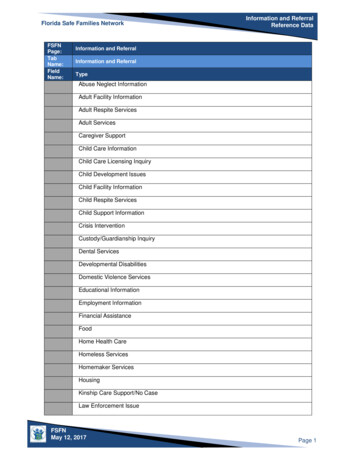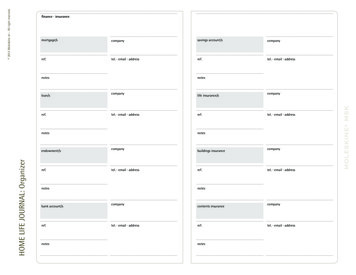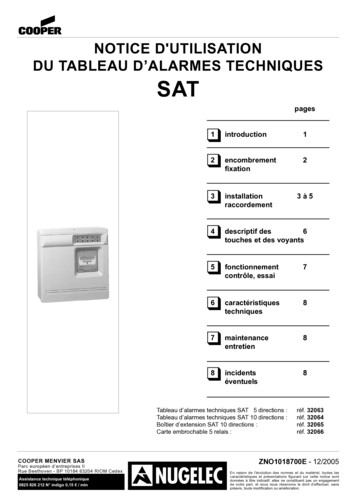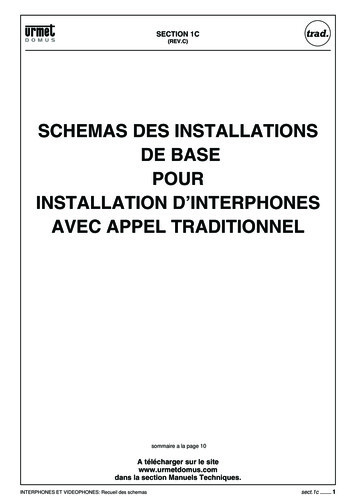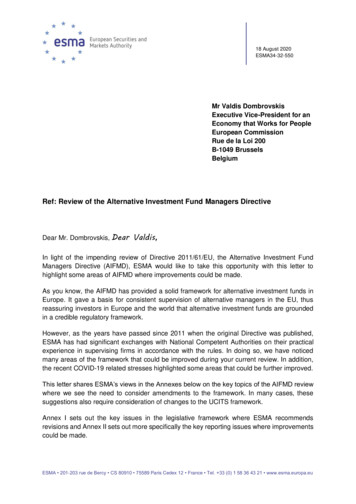
Transcription
18 August 2020ESMA34-32-550Mr Valdis DombrovskisExecutive Vice-President for anEconomy that Works for PeopleEuropean CommissionRue de la Loi 200B-1049 BrusselsBelgiumRef: Review of the Alternative Investment Fund Managers DirectiveDear Mr. Dombrovskis, DearValdis,In light of the impending review of Directive 2011/61/EU, the Alternative Investment FundManagers Directive (AIFMD), ESMA would like to take this opportunity with this letter tohighlight some areas of AIFMD where improvements could be made.As you know, the AIFMD has provided a solid framework for alternative investment funds inEurope. It gave a basis for consistent supervision of alternative managers in the EU, thusreassuring investors in Europe and the world that alternative investment funds are groundedin a credible regulatory framework.However, as the years have passed since 2011 when the original Directive was published,ESMA has had significant exchanges with National Competent Authorities on their practicalexperience in supervising firms in accordance with the rules. In doing so, we have noticedmany areas of the framework that could be improved during your current review. In addition,the recent COVID-19 related stresses highlighted some areas that could be further improved.This letter shares ESMA’s views in the Annexes below on the key topics of the AIFMD reviewwhere we see the need to consider amendments to the framework. In many cases, thesesuggestions also require consideration of changes to the UCITS framework.Annex I sets out the key issues in the legislative framework where ESMA recommendsrevisions and Annex II sets out more specifically the key reporting issues where improvementscould be made.ESMA 201-203 rue de Bercy CS 80910 75589 Paris Cedex 12 France Tel. 33 (0) 1 58 36 43 21 www.esma.europa.eu
I hope that these considerations are useful to the European Commission in its review. In caseyou have any questions, please do not hesitate to contact me or Evert van Walsum, Head ofInvestors and Issuers Department (evert.vanwalsum@esma.europa.eu).Yours sincerely,SIGNEDSteven Maijoor2
ANNEX I – ESMA’s proposed changes to AIFMD1. Harmonisation of AIFMD and UCITS regimesESMA believes that the AIFMD review is an occasion to consider greater harmonisation of theUCITS and AIFMD frameworks.In some cases, the newer AIFMD (Level 1 and/or Level 2) provisions are more granular orspecific compared to UCITS requirements, although there might not be any objectivejustification for such differences. By way of example, there are different levels of granularitywith respect to risk management and liquidity management requirements. AIFMD Level 2 setsout detailed requirements with respect to risk management (Articles 38-45) and liquiditymanagement (Articles 46-49). While this is somewhat understandable as UCITS are subjectto more detailed product requirements, it is nevertheless not ideal, taking into account thatUCITS may also face liquidity issues despite being invested in transferable securities or moneymarket instruments. The European Commission should consider aligning the frameworkswhere appropriate, in particular as applying different requirements to management companieswhich manage both UCITS and AIFs creates additional burdens for the firms concerned anddivergences in supervisory/regulatory outcomes.As an additional example, while the Level 1 provisions on delegation are rather similar(although not identical) in the UCITS Directive and AIFMD, there are no granular Level 2provisions in the UCITS framework, while this is the case in the AIFMD framework (Section 8of Chapter III of the Commission Delegated Regulation (EU) 231/2013).Moreover, the fact that the relevant EU rules are spread across numerous (interlinked) Level1 and Level 2 Directives and Regulations may add unnecessary complexity for marketparticipants and supervisors.2. Harmonised reporting for UCITSThe need for harmonisation is particularly relevant in the field of reporting. The ESRBrecommendations on liquidity and leverage risks in investment funds 1 covers this topic in itsRecommendation D on UCITS reporting. ESRB recommends that the Commission initiatelegislation to introduce a harmonised reporting regime for UCITS management companies.ESRB specifies that the Commission's proposed changes to the relevant EU legislation shouldinclude reporting obligations that cover both manager and fund-specific data while alsoreflecting the specificities of UCITS.After improvements to AIFMD Annex IV reporting have been made, harmonised UCITSreporting should generally be aligned with those requirements while allowing for tailoring to thecharacteristics of UCITS funds. To the extent possible, the reporting should try to exploit thesynergies with existing surveys both at EU and national level and avoid duplications orunnecessary burdens for the supervised entities. The reported data should allow for sufficientmonitoring of potential vulnerabilities that may contribute to systemic risk. Some lessons can1The recommendations, with more details on the envisaged proposals, are available ons/esrb.recommendation180214 ESRB 2017 6.en.pdf3
also be learned from the Money Market Fund (MMF) reporting regime that has recently beenestablished, which allows the same information to be used for both supervisory purposes andfor systemic risk monitoring.Given the value of EU-level information on UCITS funds, ESMA agrees with the ESRBRecommendation and would want to underline its importance. For example, the May 2020ESRB Recommendation on liquidity risk in investment funds2 requires ESMA to coordinate asupervisory engagement exercise with investment funds to assess their preparedness in caseof a new liquidity stress episode. This assessment should be based on the analysis of howfunds have reacted since the onset of the COVID-19 pandemic and their current situation, andon an estimation of their resilience to a future shock.Both ESMA and NCAs are using AIFMD reporting data to implement this recommendation, by(i) identifying the AIFs with large exposures to corporate debt and real estate markets, and (ii)analysing the outflows, performances and use of liquidity management tools for instance, and(iii) building a comprehensive assessment framework. ESMA does not have access to UCITSdata to apply the same approach to UCITS. Moreover, there is an important heterogeneityamong NCAs regarding the access to data on UCITS. This situation is sub-optimal, createsthe need for extensive ad-hoc data requests and slows down the time available for analysis.3. Scope of additional MiFID services and application of rulesPrevious work at the level of ESMA indicated the need for further legislative clarifications onthe scope of permissible business activities listed in Article 6(4) of the AIFMD and Article 6(3)of the UCITS Directive3 in conjunction with Annex I of the AIFMD and Annex II of the UCITSDirective. In particular, NCAs expressed divergent views on whether AIFMs (and UCITSmanagement companies) could be permitted to perform business activities other than thoseexplicitly listed in the aforementioned provisions. As a result of these interpretational issues,the list of permissible business activities of AIFMs (and UCITS management companies) insome Member States is broader than in others.Moreover, ESMA sees merit in providing legislative clarifications on the application of ruleswhen providing services pursuant to Article 6(4) of the AIFMD and Article 6(3) of the UCITSDirective. While Article 6(6) of the AIFMD and Article 6(4) of the UCITS Directive include crossreferences to certain MiFID rules, legal uncertainties remain as to the precise application ofthe MiFID and/or AIFMD/UCITS rules in some cases. By way of example, questions arosewhether and to which extent MiFID and/or AIFMD/UCITS rules could be applied todiscretionary portfolio management or investment advice on assets that do not qualify as‘financial instruments’ pursuant to Section C of Annex I of MiFID such as real estate, takinginto account that the relevant MiFID provisions do not apply to them.2The ESRB Recommendation on liquidity risk in investment funds is available ons/esrb.recommendation200514 ESRB on liquidity risks in investment funds 4a3972a25d.en.pdf3Which are not identical since Article 6(3) of the UCITS does not include the reception and transmission of orders, whereas thisis included in Article 6(4)(b)(iii) of the AIFMD. This may be another example for the need to harmonise the AIFMD and UCITSregimes.4
Similarly, different views were expressed on which rules apply in cases where investmentmanagement functions for an AIF/UCITS are performed on a delegation basis. While someNCAs considered these cases as discretionary portfolio management and therefore took theview that MiFID rules would need to be applied, other NCAs argued that the management ofAIFs/UCITS on a delegation basis would not be discretionary portfolio management and therelevant AIFM or UCITS management company performing functions on a delegation basiswould be subject to AIFMD/UCITS rules. This issue is covered further in the delegation sectionbelow.ESMA also sees merit in providing for a greater regulatory consistency and level playing fieldbetween AIFMD/UCITS and MiFID in order to ensure that entities providing similar types ofservices, such as marketing, are subject to similar regulatory standards. To this end, therewould be merit in clarifying the AIFMD, UCITS and MiFID frameworks to ensure thatAIFs/UCITS and their managers and MiFID investment firms always remain subject to thesame regulatory standards, while providing the same type of services.Finally, ESMA has noticed that the references in Article 6(6) of AIFMD and 6(4) of the UCITSDirective are references to MiFID I, which – although should be read according to the MiFID IIcorrelation table – have not been updated to reflect the requirements introduced with MiFID II.One example of this is that the transaction reporting obligation from Article 26 of MiFIR is notincluded in the list of MiFID provisions which also apply to AIFMs/UCITS managementcompanies. This means that AIFMs/UCITS management companies providing MiFID servicesare not subject to the requirement to report transactions in accordance with Article 26 of MiFIR.4. Delegation and substanceBeyond the delegation-related aspects mentioned above. ESMA sees merit in providingadditional legislative clarifications in the AIFMD and UCITS frameworks with respect todelegation and substance requirements. Such clarifications could be provided in line with thedelegation and substance-related guidance provided in the ESMA opinion to supportsupervisory convergence in the area of investment management in the context of the UnitedKingdom withdrawing from the European Union (ESMA34-45-344)4.Extent of delegationIn many cases, AIFMs and UCITS management companies delegate to a large extent thecollective portfolio management functions listed in Annex I of the AIFMD and Annex II of theUCITS Directive to third parties and only perform some control functions internally (notably riskmanagement functions). In particular, portfolio management functions are often largely or evenentirely delegated to third parties within or outside of the group of the AIFM or UCITSmanagement company. Moreover, in light of the withdrawal of the UK from the EU, delegationof portfolio management functions to non-EU entities is likely going to further increase.Such extensive delegation arrangements may result in a situation where the majority of humanand technical resources (e.g. IT systems) needed for the day-to-day operations are maintained4The ESMA opinion is available at: ment-in-context-united5
by several third parties or even a single third party, potentially outside of the EU. In thesecases, the majority of operational staff performing portfolio/risk management, administrationand other functions work on a delegation basis for the relevant funds and are therefore notdirectly employed by the authorised AIFM or UCITS management company. As aconsequence of this, and as an important indicator for extensive delegation arrangements, alarge amount of the management fees generated by the authorised AIFM or UCITSmanagement company are paid to delegates. While such extensive use of delegationarrangements may increase efficiencies and ensure access to external expertise taking intoaccount the global nature of financial markets, they may also increase operational andsupervisory risks and raise questions as to whether those AIFs and UCITS can still beeffectively managed by the licensed AIFM or UCITS management companies.Against this background, further legal clarifications on the maximum extent of delegation wouldbe helpful to ensure supervisory convergence and ensure authorised AIFMs and UCITSmanagement companies maintain sufficient substance in the EU. In particular, ESMA seesmerit in reviewing Article 82 of the Commission Delegated Regulation (EU) No 231/2013 whichmay benefit from a clearer legal drafting. In this context, the Commission may in particular wishto reconsider and/or complement the qualitative criteria set in Article 82(1)(d) with clearquantitative criteria or provide a list of core or critical functions that must always be performedinternally and may not be delegated to third parties. Such considerations should be matchedalso in the UCITS Directive.Applicable regime in case of delegation and regulatory arbitrageIn many cases, the delegates are subject to different regulatory regimes which adds furtherregulatory complexity and provides for additional supervisory challenges for NCAs, in particularwhere the delegate is established in another Member State or outside of the EU. Dependingon the regulatory license of the delegate, questions may also arise about regulatory levelplaying field and possible circumvention of AIFMD/UCITS regulatory standards. In the case ofdelegation to another regulated EU entity, this is often a question of regulatory consistencybetween the various EU regulatory regimes (for example, but not limited to, the issues on thelack of harmonisation between the AIFMD, UCITS and MiFID rules described above). In thecase of delegation to non-EU delegates, the regulatory arbitrage and investor protectionconcerns may be further increased since the non-EU delegate will not be directly subject tothe AIFMD or UCITS frameworks. Consequently, AIFs and UCITS can be largely managed ona day-to-day basis by third parties (within or outside of the EU) that are not directly subject tothe AIFMD or UCITS Directive. To avoid regulatory arbitrage and protect EU investors,legislative amendments should ensure that the management of AIFs and UCITS is subject tothe regulatory standards set out in the AIFMD and UCITS frameworks, irrespective of theregulatory license or location of the delegate.Use of seconded staffFurthermore, ESMA has also observed an increasing use of secondment arrangements wherestaff from professional services firms/consultancies or group entities are seconded to the AIFMor UCITS management company on a temporary basis. In some of those cases, the secondedstaff was not operating in the Member State of establishment of the authorised AIFM or UCITSmanagement company, but in another Member State or even outside of the EU (e.g. staff of6
other group entities being seconded to the authorised entity in the EU but continuing to workfrom their usual offices outside of the EU on a secondment rather than delegation basis). Thisraises questions whether those secondment arrangements are in line with the substance anddelegation rules set out in the AIFMD and UCITS frameworks. Further legislative clarificationscould be helpful to address these questions.List of collective portfolio management functions and distinction from ‘supporting tasks’Group entities within or outside of the EU often provide ‘supporting tasks’ to the authorisedAIFM or UCITS management company. In the absence of clear legal definitions or anexhaustive list of collective portfolio management functions set out in Annex I of the AIFMDand Annex II of the UCITS Directive, it is often difficult for NCAs to assess whether the‘supporting tasks’ provided by the group entities are subject to the delegation rules set out inthe AIFMD and UCITS Directive or not. By way of example, previous discussions at the levelof ESMA indicated that NCAs had divergent interpretations on the question of whether in caseswhere another entity in a third country performed legal or compliance tasks, this should beviewed as a delegation of the legal or compliance functions listed in Annex I of the AIFMD andAnnex II of the UCITS Directive. Similar questions arose in cases where other entities (oftenoutside of the EU) performed portfolio or risk management-related tasks such as investmentresearch activities or (quantitative) risk data analyses or calculations. In the absence of legalclarifications on the scope of the Annex I and Annex II functions, NCAs expressed divergentviews on whether those activities qualify as mere ‘supporting tasks’ or rather as collectiveportfolio management functions subject to the delegation regimes set out in the AIFMD andUCITS frameworks.While certain recitals and general provisions laid down in the Commission DelegatedRegulation (EU) No 231/2013 may help to address some of the issues above, more specificand granular requirements would be desirable in order to ensure legal certainty andsupervisory convergence. 5 In this context, ESMA sees merit in implementing legislativeclarifications in line with the interpretation supported by ESMA in Section VIII of its Q&As onthe application of the AIFMD (ESMA34-32-352)6. This would particularly aim to eliminate anyresidual legal uncertainties as to responsibilities of AIFMs for ensuring that the collectiveportfolio management functions set out in Annex I of the AIFMD are performed in compliancewith the AIFMD rules.White-label service providersFinally, more specific requirements on white-label service providers 7 would be advisable.These types of fund managers exist since many years in several Member States, whereasNCAs in other Member States have expressed doubts as to whether those business modelswould be in line with the AIFMD and UCITS regimes. Should such business models be5And consistent Level 2 delegation requirements should be introduced in the UCITS framework, where currently no suchdetailed Level 2 provisions exist.6The ESMA Q&As are available at: rary/esma34-32-352 qa aifmd.pdf7Meaning fund managers that provide a platform to business partners by setting up funds at the initiative of the latter andtypically delegating investment management functions to those initiators/business partners or appointing them as investmentadvisers or informally following their guidance/instructions. ESMA addressed risks stemming from white-label service providersin the context of Brexit-related relocations in paragraph 36 of the ESMA opinion to support supervisory convergence in the areaof investment management in the context of the United Kingdom withdrawing from the European Union (ESMA34-45-344).7
permissible in the view of the European Commission, more specific regulatory provisionswould be advisable, in particular to address the distinct and significant conflicts of interest andinvestor protection risks faced in these cases. This is mainly because the initiator/businesspartner of white-label (or third-party) funds is also the client of the authorised AIFM or UCITSmanagement company and may therefore decide to replace the authorised AIFM or UCITSmanager with another white-label service provider. In many cases, the relevant funds evencarry the name of the initiator/business partner8. Therefore, the initiator/business partner mayeffectively be able to exercise significant influence over the authorised AIFM or UCITSmanager. Where the initiator/business partner performs portfolio management on a delegationbasis or is appointed as investment adviser, the authorised AIFM or UCITS managementcompany will face significant conflicts of interest since controlling and challenging thedelegate/investment adviser in the best interest of investors may come at the risk of losing aclient/business partner and therefore losing its own revenue/management fees. Changesshould also be reflected in the UCITS Directive.5. Availability of additional liquidity management toolsESMA believes that the availability of additional liquidity management tools (LMT) should beconsistent throughout all EU jurisdictions. This is reflected in ESRB’s Recommendation A onliquidity management tools from the ESRB 2017 Recommendation on liquidity and leveragerisks in investment funds.9 The experience of market dislocation during the on-going COVID19 crisis also demonstrates the need for all LMT to be available in all jurisdictions in aconsistent manner. A common Union legal framework governing the liquidity managementtools would support this. Furthermore, the ESRB’s public statement on the use of liquiditymanagement tools by investment funds with exposures to less liquid assets issued on 13 May2020 noted that recent market developments highlight the need to make progress inimplementing the 2017 ESRB Recommendation and to introduce adequate legal backing forthe use of such instruments.10In ESMA’s view, the Commission should take the opportunity of this AIFMD review to includeavailability of all LMTs outlined in ESRB recommendation A. In addition, the availability of toolsshould also be included in the UCITS Directive (noting that some of the tools will not be suitableor necessary for all types of funds, e.g. side pockets).The COVID-19 situation reinforces the relevance of the ESRB Recommendations. Forexample, ESRB Recommendation A(2) recommends enhanced provisions to AIFMD (andUCITS) clarifying the roles of National Competent Authorities (NCAs) when using their powersto suspend redemptions in situations where there are cross-border financial stabilityimplications. If an investment fund is established in one Member State but the AIFM or theUCITS management company is based in another, it might not be clear which NCA is8E.g. the Woodford case, see t-management-portfolio-letter.pdf (page 3) schroders-ceo-20190801.9The ESRB Recommendation on liquidity and leverage risks in investment funds is available ons/esrb.recommendation180214 ESRB 2017 6.en.pdf10The ESRB public statement is available red/pdf/esrb.publicstatement200514 on the use of liquidity manage ment tools by investment funds with exposures to less liquid assets.en.pdf.8
responsible for supervising the suspension of redemptions and subscriptions or thecircumstances justifying an authority intervening with suspension powers.In addition, ESMA believes there is merit in ESRB Recommendation A(3), which proposes thatthe legislation set out more specific provisions on ESMA's facilitation, advisory andcoordination role in relation to the suspension of redemptions and subscriptions, in particularin situations where there are cross-border financial stability implications.6. LeverageAIFMD has two measures of leverage calculation, the gross notional exposure (GNE) methodand the commitment method. Both are used for reporting purposes. IOSCO issued inDecember 2019 its recommendations for a framework assessing leverage in investmentfunds.11 IOSCO recommends a two-step approach for this framework. Step 1 uses measuresof leverage as baseline analytical tools to identify funds that may pose a risk to financialstability. Step 2 entails a risk-based analysis of the subset of funds identified in Step 1.The goal of Step 1 is to provide regulators with a means of efficiently identifying those fundsthat are more likely to pose risks to the financial system using at least one notional exposuremetric of the metrics outlined by IOSCO in its report:(i)GNE without adjustments reported broken down by asset class, long and shortexposures; and/or(ii)adjusted GNE reported broken down by asset class, long and short exposures.Moreover, in the process of refining its Step 1 analysis, a regulator may also complement GNEor adjusted GNE metrics with netting and hedging assumptions as relevant (such as thecommitment method). Additional data points may also be used as a regulator sees fit.ESMA believes the IOSCO recommendations give rise to a need to amend the currentreporting of the gross method calculation in Article 7 of the Commission Delegated Regulation(EU) No 231/2013, to ensure alignment with the IOSCO framework.In addition, there is merit in considering amending the commitment amount calculation byadjusting the notional amounts of interest rate derivatives contracts by the duration of the tenyear bond equivalent.12 This adjustment allows comparability among contracts with differentunderlying duration, which makes aggregation and comparison possible for systemic riskmonitoring purposes. This would be useful also in the context of any harmonised UCITSreporting, as further explored above in Section 2.7. AIFMD reporting regime and data use11The IOSCO Recommendations for a Framework Assessing Leverage in Investment Funds is available PD645.pdf12As described in the IOSCO recommendations on page 89
ESMA has conducted a separate ad-hoc analysis of the issues it sees merit in addressingregarding the AIFMD reporting regime and data use. This analysis can be read in full in AnnexII below.8. Harmonisation of supervision of cross-border entitiesExperience with the AIFMD (and UCITS) framework shows that there is still a lack of clarity inwhat the precise responsibilities of home and host supervisors are in some cross-bordermarketing, management and delegation cases. Clarification of the supervisory responsibilitieswould reduce uncertainty regarding cross-border activities within the internal market andbenefit the Capital Markets Union (CMU).This is because AIFMs often use branches and/or delegate a variety of functions to multiplethird parties across different Member States (and non-EU jurisdictions), which gives addedimpetus to ensuring clear supervisory responsibilities and effective exchange of informationamong all relevant NCAs.Some further legislative clarifications could therefore be provided regarding the supervision ofcross-border activities of UCITS and AIFs, (including MMFs, EuVECAs, EuSEFs and ELTIFs),their managers (including cases where they use branches in other Member States or outsideof the EU) and delegates.For example, in the case of AIF suspensions, there are general provisions in the AIFMD inrelation to exchange of information. However, it would be useful to further clarify thesupervisory responsibilities and obligations to share information with other NCAs and ESMA.ESMA also sees the need for the Commission to provide further clarity on the depth of theanalysis to be done by the host NCA when AIFs are marketed on a cross-border basis underArticle 32 AIFMD. While the home NCA normally makes an assessment of all the relevant funddocuments in the authorisation stage, the tasks attributed to the host NCAs – currentlyspecified in Article 32(5) – could be better specified, including the reference to thecompleteness of the documents attached in the notification and to the supervision on marketingcommunications.There is the need to further clarify the roles and responsibilities of home and host NCAs whereAIFs are managed on a cross-border basis under Article 33 AIFMD.The supervision of branches is another area where ESMA sees merit in further harmonisation.When an AIFM establishes a branch in order to offer products in a host jurisdiction, it is notclear what the roles of that AIFM’s home and host NCAs are in some cases. It is also not clearwhat the procedure is for home and host NCAs when an AIFM wants to close a branch, nor isthere a register of branches.9. Semi-professional investorsCurrently there is no definition of “semi-professional” investor in AIFMD. There are, however,slightly different approaches used in the EuVECA, EuSEF and ELTIF regulations.10
ESMA has already called for greater convergence in the definition of “professional investor” inits 2015 opinion on the functioning of the AIFMD EU passport and of the National PrivatePlacement Regimes (NPPRs).13 ESMA identified a wide variety of definitions across the EU onwhat constitutes a “professional investor”, and a wide variety of treatments of the status of“semi-professional” investors under NPPRs.ESMA sees merit to clarify the definition of “professional investors” under AIFMD, and is of theview that any possible introduction of any new categories of investors under the AIFMD (suchas “semi-professional” investors) should be accompanied by appropriate investor protectionrules and that passporting activities should be allowed only in relation to the marketing toprofessional investors.10. Loan origination in AIFMDESMA believes that there should be a specific framework for loan origination within the AIFMD.It would be particularly helpful for the EU effort to promote a capital markets union (CMU).ESMA already issued an opinion on key principles for a European framework on loanorigination by funds14 in April 2016.The ESMA opinion contains recommendations on authorisation for loan originating funds,types of funds (cl
services, such as marketing, are subject to similar regulatory standards. To this end, there would be merit in clarifying the AIFMD, UCITS and MiFID frameworks to ensure that AIFs/UCITS and their managers and MiFID investment firms always remain subject to the same regulatory standards, while providing the same type of services.
